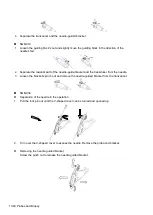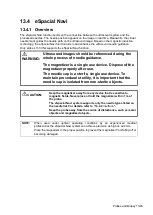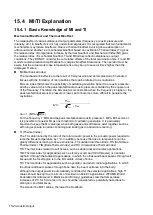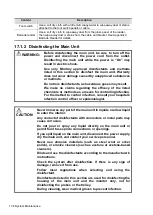
15-2 Acoustic Output
15.4 MI/TI Explanation
15.4.1 Basic Knowledge of MI and TI
Mechanical Bioeffect and Thermal Bioeffect
The relationship of various ultrasound output parameters (frequency, acoustic pressure and
intensity, etc.) to bioeffects is not fully understood at present. It is recognized that two fundamental
mechanisms may induce bioeffects. One is a thermal bioeffect involving tissue absorption of
ultrasound, and another is a mechanical bioeffect based on cavitations. Thermal Index (TI) gives
the relative index of temperature increase by thermal bioeffect, and Mechanical Index (MI) gives
the relative index of mechanical bioeffect. TI and MI indices reflect instantaneous output
conditions. They DO NOT consider the cumulative effects of the total examination time. TI and MI
models contain practical simplifications for complex bioeffect interactions. The operator must be
aware that the actual worst case temperature rise may be up to several times higher than the
displayed TI value.
MI (Mechanical Index)
The mechanical bioeffects are the result of Compression and decompression of insonated
tissues with the formation of micro bubbles that can be referred to as cavitations.
MI is an index that shows the possibility of cavitation generation based on acoustic pressure,
and the value at which the peak rarefactional acoustic pressure is divided by the square root
of the frequency. Therefore, the MI value becomes smaller when the frequency is higher or the
peak rarefactional acoustic pressure is lower, and it becomes more difficult to generate the
cavitations.
MI
=
P
r,
awf
f
C
MI
C
MI
= 1 (MPa / MHz )
For the frequency 1 MHz and the peak rarefactional acoustic pressure 1 MPa, MI becomes 1.
It is possible to consider MI as one threshold of cavitation generation. It is particularly
important to keep the MI value low when both gases and soft tissues exist together, such as
with lung exposure in cardiac scanning and bowel gas in abdominal scanning.
TI (Thermal Index)
The TI is determined by the ratio of the total acoustic power to the acoustic power required to
raise the tissue temperature by 1°C. In addition, because the raise in temperature can be
greatly different according to tissue structures, TI is divided into three kinds: TIS (Soft-tissue
Thermal Index), TIB (Bone Thermal Index) and TIC (Cranial-bone Thermal Index).
TIS: Thermal index related to soft tissues, such as abdominal and cardiac applications.
TIB: Thermal index for applications such as fetal (second and third trimester) or neonatal
cephalic (through the fontanel) applications, in which the ultrasound beam passes through soft
tissue and the focal region is in the immediate vicinity of bone.
TIC: Thermal index for applications such as pediatric and adult cranial applications, in which
the ultrasound beam passes through bone near the beam entrance into the body.
Although the output power is automatically controlled for the selected applications, high TI
values should be kept to a minimum or avoided in obstetric applications. WFUMB (World
Federation for Ultrasound in Medicine and Biology) guidelines state that temperature
increases of 4°C for 5 minutes or more should be considered as potentially hazardous to
embryonic and fetal tissue.
The smaller the MI/TI values, the lower the bioeffects.
Summary of Contents for TE5
Page 1: ...TE7 TE5 Diagnostic Ultrasound System Operator s Manual Basic Volume ...
Page 2: ......
Page 6: ......
Page 12: ......
Page 24: ......
Page 36: ......
Page 54: ......
Page 110: ......
Page 115: ...Display Cine Review 6 5 6 Tap Return on the screen or tap Freeze to exit image compare ...
Page 120: ......
Page 124: ......
Page 156: ......
Page 174: ......
Page 192: ...12 18 Setup Select Advanced and do as follows Select MAPS and do as follows ...
Page 202: ...13 2 Probes and Biopsy C5 2s L12 4s L7 3s P4 2s L14 6s C11 3s L14 6Ns V11 3Ws P7 3Ts 7LT4s ...
Page 226: ...13 26 Probes and Biopsy NGB 034 NGB 035 ...
Page 250: ......
Page 272: ......
Page 276: ...A 4 Wireless LAN Tap Add Manually create a network profile to set ...
Page 282: ......
Page 318: ......
Page 322: ......
Page 323: ...P N 046 006959 07 1 0 ...
















































